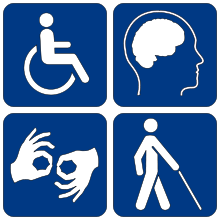
Back Gestremdheid Afrikaans Behinderung ALS Discapacitat AN Unmeaht ANG إعاقة Arabic প্ৰতিবন্ধকতা Assamese Discapacidá AST Əlillik Azerbaijani علیللیک AZB Зәғифлек Bashkir

Disability is a condition that a person has which limits them in some way.[1] These conditions may be congenital (present at birth), cognitive (to do with the brain), developmental (appears as the person develops), physical (for example, caused by an accident or infection), sensory, or a combination of factors.
The United Nations Convention on the Rights of Persons with Disabilities defines disability in Article 1 as:
- "long-term physical, mental, intellectual or sensory impairments which in interaction with various barriers may hinder [a person's] full and effective participation in society on an equal basis with others".
Invisible disabilities, or hidden disabilities, are disabilities that are not immediately obvious. Some examples of invisible disabilities are intellectual disabilities, autism spectrum disorder, attention deficit hyperactivity disorder, mental disorders, asthma, epilepsy, allergies, migraines, arthritis, and chronic fatigue syndrome.[2]
People with a disability or disabilities may need to use special equipment that can help them. This can include using a wheelchair, a cane or walking stick, hearing aids, a teletypewriter (TTY) and using specially designed software and hardware for the personal computer.
People who use a wheelchair cannot walk up or down stairs in a building. They need to use ramps and elevators (lifts) going into and moving around in a building. Wide doorways and accessible toilets also make it easier for people with physical disabilities to use.
Prejudice towards people with disabilities is common. This is sometimes called 'ableism'. People with such a prejudice are called an ablecentrists.[3]
- ↑ DePoy, Elizabeth; Gilson & Stephen French 2004. Rethinking disability: principles for professional and social change. Pacific Grove, CA: Brooks Cole. ISBN 978-0-534-54929-9
- ↑ "Invisible Disabilities: List & Information" (PDF). Disabled World. 2015-10-28. Retrieved 2021-02-15.
- ↑ Goodley, Dan, and Katherine Runswick‐Cole. 2011. The violence of disablism. in Sociology of health & illness 33.4: 602-617.